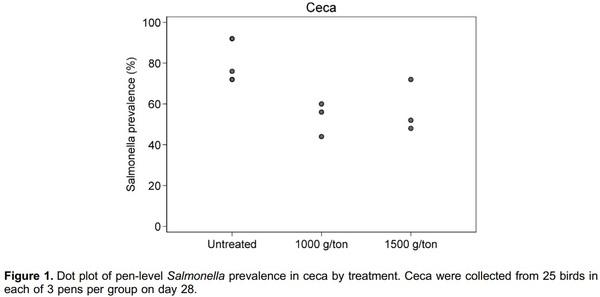Bacteriophage in-feed application: A novel approach to preventing Salmonella Enteritidis colonization in chicks fed experimentally contaminated feed





REFERENCES
Adhikari, P. A., D. E. Cosby, N. A. Cox, J. H. Lee, and
W. K. Kim. 2017. Effect of dietary bacteriophage supplementation on internal organs, fecal excretion, and ileal immune response in laying hens challenged by Salmonella
Enteritidis. Poult. Sci. 96:3264–3271.
Atterbury, R. J., P. L. Connerton, C. E. Dodd, C. E.
Rees, and I. F. Connerton. 2003. Application of host-specific bacteriophages to the surface of chicken skin leads to a reduction in recovery of Campylobacter jejuni. Appl. Environ. Microbiol. 69:6302–6306.
Atterbury, R. J., M. A. Van Bergen, F. Ortiz, M. A.
Lovell, J. A. Harris, A. De Boer, J. A. Wagenaar, V. M.
Allen, and P. A. Barrow. 2007. Bacteriophage therapy to reduce salmonella colonization of broiler chickens. Appl.
Environ. Microbiol. 73:4543–4549.
Berghaus, R. D., S. G. Thayer, B. F. Law, R. M. Mild,
C. L. Hofacre, and R. S. Singer. 2013. Enumeration of
Salmonella and Campylobacter spp. in environmental farm samples and processing plant carcass rinses from commercial broiler chicken flocks. Appl. Environ. Microbiol.
79:4106–4114.
Blodgett, R. J. 2010. Does a serial dilution experiment’s model agree with its outcome? Model Assisted Stat. Appl.
5:209–215.
Borie, C., M. L. Sanchez, S. Ramirez, M. A. Morales, J.
Retamales, and J. Robeson. 2009. Aerosol spray treatment with bacteriophages and Competitive Exclusion reduces
Salmonella enteritidis infection in chickens. Avian Dis.
53:250–254.
Boyer, J., C. I, S. Narotsky, D. W. Brunner, and J. A.
Brown. 1962. Salmonellosis in Turkeys and chickens associated with contaminated feed. Avian Dis. 6:45–50.
Crump, J. A., P. M. Griffin, and F. J. Angulo. 2002.
Bacterial contamination of animal feed and its Relationship to human foodborne illness. Clin. Infect. Dis.
35:859–895.
Fiorentin, L., N. D. Vieira, and W. Barioni Jr. 2005. Oral treatment with bacteriophages reduces the concentration of
Salmonella Enteritidis PT4 in caecal contents of broilers.
Avian Pathol. 34:258–263.
Golkar, Z., O. Bagasra, and D. G. Pace. 2014. Bacteriophage therapy: a potential solution for the antibiotic resistance crisis. J. Infect. Dev. Ctries. 8:129–136.
Gong, C., and X. Jiang. 2017. Application of bacteriophages to reduce Salmonella attachment and biofilms on hard surfaces. Poult. Sci. 96:1838–1848.
Gong, C., X. Jiang, and J. Wang. 2017. Application of bacteriophages to reduce Salmonella contamination on workers’ boots in rendering-processing environment. Poult.
Sci. 96:3700–3708.
Goode, D., V. M. Allen, and P. A. Barrow. 2003.
Reduction of experimental Salmonella and Campylobacter contamination of chicken skin by application of lytic bacteriophages. Appl. Environ. Microbiol. 69:5032–5036.
Higgins, S. E., J. P. Higgins, L. R. Bielke, and B. M.
Hargis. 2007. Selection and application of bacteriophages for treating Salmonella enteritidis infections in poultry. Int.
J. Poult. Sci. 6:163–168.
Hungaro, H. M., R. C. S. Mendonça, D. M. Gouvêa, M.
C. D. Vanetti, and C. L.d. O. Pinto. 2013. Use of bacteriophages to reduce Salmonella in chicken skin in comparison with chemical agents. Food Res. Int. 52:75–81.
Joerger, R. D. 2003. Alternatives to antibiotics: bacteriocins, antimicrobial peptides and bacteriophages. Poult.
Sci. 82:640–647.
Johnson, R. P., C. L. Gyles, W. E. Huff, S. Ojha, G. R.
Huff, N. C. Rath, and A. M. Donoghue. 2008. Bacteriophages for prophylaxis and therapy in cattle, poultry and pigs. Anim. Health Res. Rev. 9:201–215.
Jones, F. T. 2011. A review of practical Salmonella control measures in animal feed. J. Appl. Poult. Res. 20:102–113.
Kim, J. H., J. W. Kim, H. S. Shin, M. C. Kim, J. H. Lee,
G. B. Kim, and D. Y. Kil. 2015. Effect of dietary supplementation of bacteriophage on performance, egg quality and caecal bacterial populations in laying hens. Br. Poult. Sci.
56:132–136.
Kim, K. H., G. Y. Lee, J. C. Jang, J. E. Kim, and Y. Y.
Kim. 2013. Evaluation of Anti-SE bacteriophage as feed additives to prevent Salmonella enteritidis (SE) in broiler. AsianAustralas. J. Anim. Sci. 26:386–393.
Lilkebkelke, K. A., C. L. Hofacre, T. Liu, D. G. White, S.
Ayers, S. Young, and J. Muarer. 2005. Vertical and horizontal Transmission of Salmonella within Integrated broiler production System. Foodborne Pathog. Dis. 2:90–102.
Long, J. S. 1997. Regression Models for Categorical and
Limited Dependent Variables. SAGE, Thousand Oaks, CA.
Maciorowski, K. G., P. Herrera, F. T. Jones, S. D. Pillai, and S. C. Ricke. 2007. Effects on poultry and livestock of feed contamination with bacteria and fungi. Anim. Feed Sci.
Technol. 133:109–136.
Marin, C., and M. Lainez. 2009. Salmonella detection in feces during broiler rearing and after live transport to the slaughterhouse. Poult. Sci. 88:1999–2005.
Miller, R. W., E. J. Skinner, A. Sulakvelidze, G. F.
Mathis, and C. L. Hofacre. 2010. Bacteriophage therapy for control of necrotic enteritis of broiler chickens experimentally infected with Clostridium perfringens. Avian Dis.
54:33–40.
National Research Council (NRC). 1994. Nutrient Requirements of Poultry. 9th ed. NRC, Washington, DC.
Pennington, J. H., N. H. Brooksbank, P. M. Poole, and
F. Seymour. 1968. Salmonella virchow in a chicken-packing station and associated rearing Units. Br. Med. J. 4:804–806.
Pyle, N. J. 1925. The Bacteriophage in relation to Salmonella pullora infection in the domestic fowl. J. Bacteriol.
12:245–261.
Rajan, K., Z. Shi, and S. C. Ricke. 2017. Current aspects of Salmonella contamination in the US poultry production chain and the potential application of risk strategies in understanding emerging hazards. Crit. Rev. Microbiol.
43:370–392.
Scallan, E., R. M. Hoekstra, F. J. Angulo, R. V. Tauxe,
M. A. Widdowson, S. L. Roy, J. L. Jones, and P. M. Griffin.
2011. Foodborne illness acquired in the United States–major pathogens. Emerg. Infect. Dis. 17:7–15.
Schleifer, J. H., B. J. Juven, C. W. Beard, and N. A.
Cox. 1984. The susceptibility of chicks to Salmonella montevideo in Artificially contaminated poultry feed. Avian
Dis. 28:497–503.
Sharma, S., S. Chatterjee, S. Datta, R. Prasad, D. Dubey,
R. K. Prasad, and M. G. Vairale. 2017. Bacteriophages and its applications: an overview. Folia Microbiol. 62:17–55.
Sheldon, B. W., and J. Brake. 1991. Hydrogen peroxide as an alternative hatching egg disinfectant. Poult. Sci.
70:1092–1098.
Sillankorva, S., E. Pleteneva, O. Shaburova, S. Santos,
C. Carvalho, J. Azeredo, and V. Krylov. 2010. Salmonella
Enteritidis bacteriophage candidates for phage therapy of poultry. J. Appl. Microbiol. 108:1175–1186.
Smyser, C. F., and G. H. Snoeyenbos. 1979. Evaluation of organic acids and other compounds as Salmonella antagonists in meat and bone meal. Poult. Sci. 58:50–54.
Tobin, J. 1958. Estimation of relationships for limited dependent variables. Econometrica. 26:24–36.
Toro, H., S. B. Price, S. McKee, F. J. Hoerr, J. Krehling,
M. Perdue, and L. Bauermerister. 2005. Use of bacteriophages in Combination with Competitive Exclusion to reduce Salmonella from infected chickens. Avian Dis. 49:118–124.
Wang, G. Y., P. Tu, X. Chen, Y. G. Guo, and S. X.
Jiang. 2013a. Effect of three polyether ionophores on pharmacokinetics of florfenicol in male broilers. J. Vet.
Pharmacol. Ther. 36:494–501.
Wang, J. P., L. Yan, J. H. Lee, and I. H. Kim. 2013b.
Evaluation of bacteriophage supplementation on growth performance, blood characteristics, relative organ weight, breast muscle characteristics and excreta microbial shedding in broilers. Asian-Australas. J. Anim. Sci. 26:573–578.
Wernicki, A., A. Nowaczek, and R. Urban-Chmiel.
2017. Bacteriophage therapy to combat bacterial infections in poultry. Virol. J. 14:179.
Young, S. D., O. Olusanya, K. H. Jones, T. Liu, T. A.
Liljebjelke, and C. L. Hofacre. 2007. Salmonella Incidence in broilers from breeders Vaccinated with live and killed
Salmonella. J. Appl. Poult. Res. 16:521–528.
Zhao, P. Y., H. Y. Baek, and I. H. Kim. 2012. Effects of bacteriophage supplementation on egg performance, egg quality, excreta microflora, and moisture content in laying hens. Asian-Australas. J. Anim. Sci. 25:1015–1020.











.jpg&w=3840&q=75)